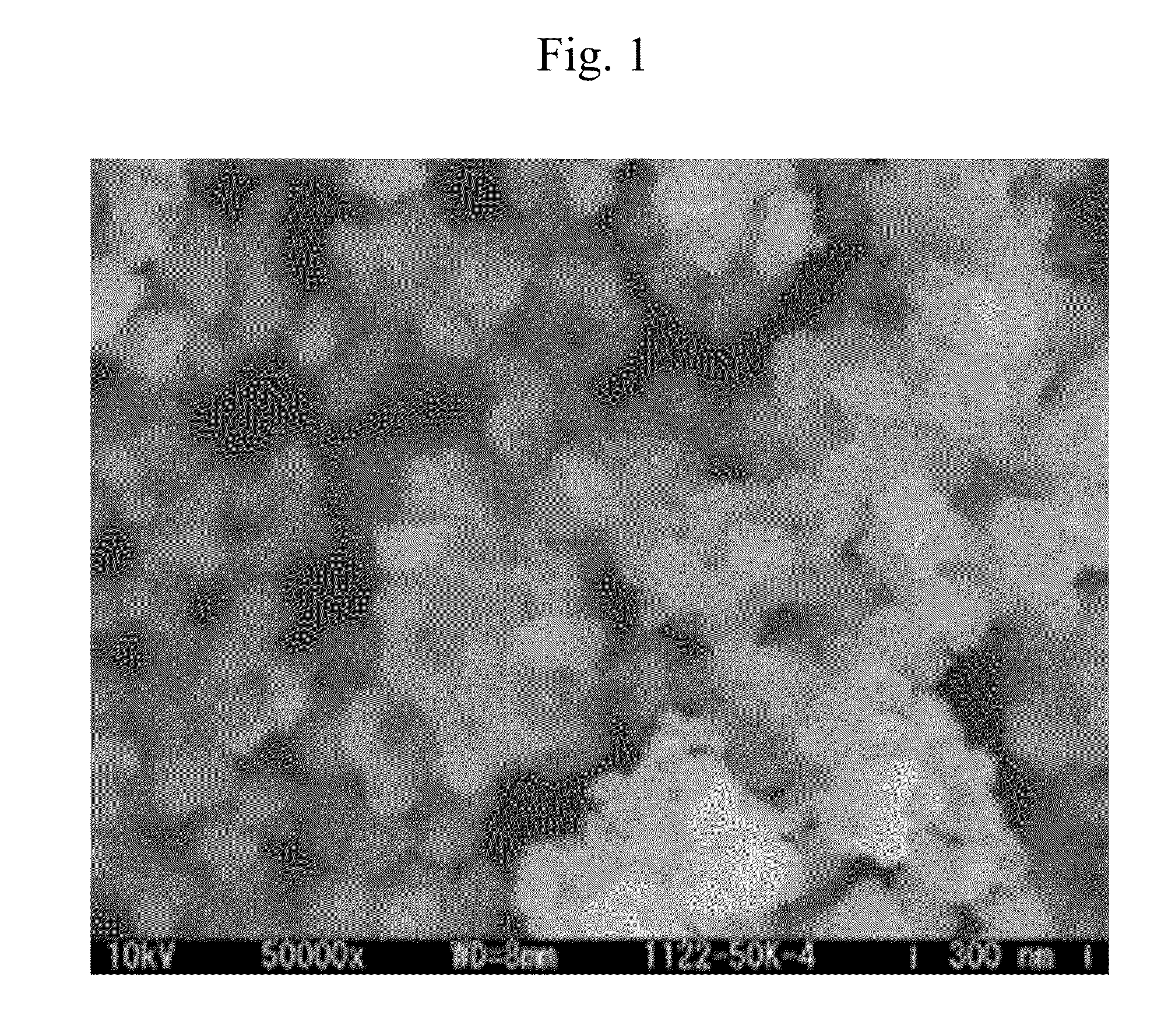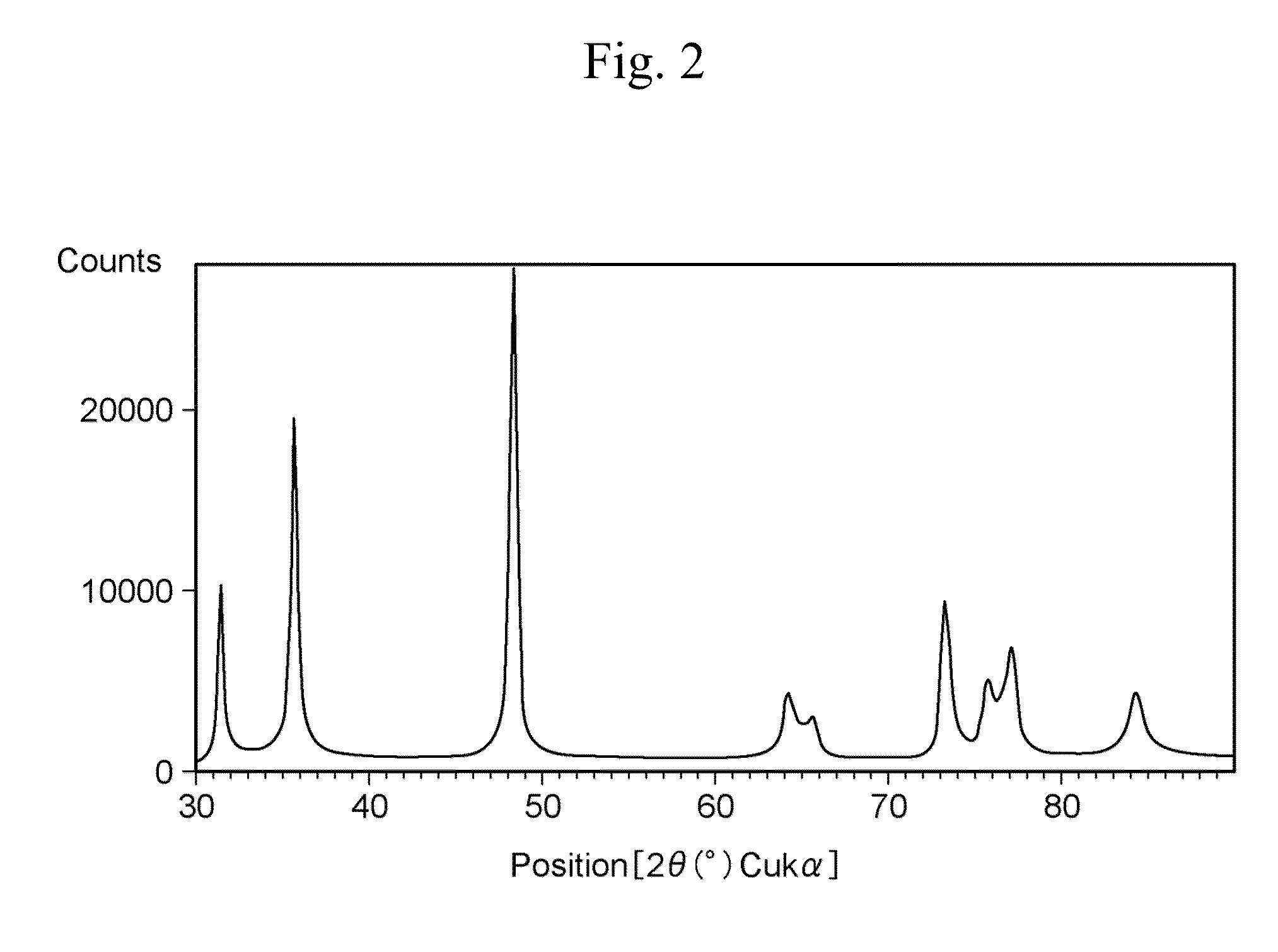Fine metal carbide particles and methods of manufacturing the same
a technology of metal carbide and fine particles, which is applied in the field of metal carbide fine particles, can solve the problems of increasing production costs, complex process, and requiring a great deal of heat energy, and not a manufacturing method of metal carbide, and achieves the effect of small average particle diameter and cost reduction
- Summary
- Abstract
- Description
- Claims
- Application Information
AI Technical Summary
Benefits of technology
Problems solved by technology
Method used
Image
Examples
examples
[0089]Next, examples which have been carried out in order to verify the advantages of the present invention will be described. Herein, FIG. 1 is a scanning electron micrograph of fine tungsten carbide particles manufactured in Example 2, and FIG. 2 is a powder X-ray diffraction pattern of the fine tungsten carbide particles.
[0090]A shape of the metal carbide fine particles was observed by a scanning electron microscope (SEM), and an average particle diameter of the fine particles was determined by an image analysis. A crystal structure was determined by powder X-ray diffraction measurement.
[0091]The total carbon amount of the fine particles was analyzed by an infrared absorption method. The content of an element of metal impurities was determined from the result of inductively-coupled plasma (ICP) emission spectrometry.
examples 1 to 4
, and Comparative Examples 1 to 4
[0092]Tungsten carbide fine particles were manufactured under various conditions different in the molar ratio between anhydrous citric acid and tungstic acid, the calcining atmospheres and the calcining temperature. Hereinafter, the case shown as Example 2 in the following Table 1 will be described.
[0093]To 160 ml of an ammonia aqueous solution with a pH of 11.6, 22 g of tungstic acid was added. After dissolution of tungstic acid, 17 g of anhydrous citric acid was added as a carbon source, and the resulting mixture was stirred until a metal complex solution is formed. All of the above-mentioned steps were carried out with stirring. Next, the metal complex solution was dried, and the resulting solid was pulverized with an agate mortar. The resulting powder was put in a crucible made of graphite and heated up to 1150° C. in an argon atmosphere or in a vacuum. Then the powder was maintained at this temperature for 4 hours, and thereafter naturally coole...
example 5
Production of Vanadium Carbide Fine Particles
[0097]To 300 ml of distilled water, 15 g of ammonium vanadate was added, and the resulting mixture was stirred to dissolve ammonium vanadate. Then, 31.6 g of anhydrous citric acid was added as a carbon source, and the resulting mixture was stirred until a uniform solution was obtained.
[0098]Next, the aqueous metal complex solution thus obtained was dried, and the resulting solid was pulverized with an agate mortar. The resulting powder was put in a crucible made of graphite and heated up to 1100° C. in an argon gas flow. Then the powder was maintained at this temperature for 4 hours, and thereafter naturally cooled to be heat-treated to obtain a composition.
PUM
| Property | Measurement | Unit |
|---|---|---|
| particle diameter | aaaaa | aaaaa |
| temperature | aaaaa | aaaaa |
| molar ratio | aaaaa | aaaaa |
Abstract
Description
Claims
Application Information
 Login to View More
Login to View More - R&D
- Intellectual Property
- Life Sciences
- Materials
- Tech Scout
- Unparalleled Data Quality
- Higher Quality Content
- 60% Fewer Hallucinations
Browse by: Latest US Patents, China's latest patents, Technical Efficacy Thesaurus, Application Domain, Technology Topic, Popular Technical Reports.
© 2025 PatSnap. All rights reserved.Legal|Privacy policy|Modern Slavery Act Transparency Statement|Sitemap|About US| Contact US: help@patsnap.com



